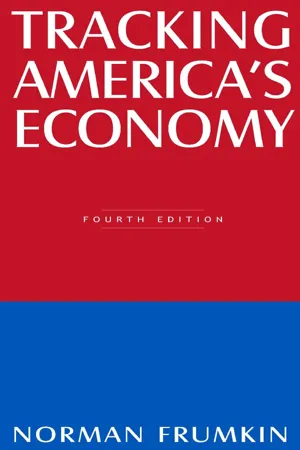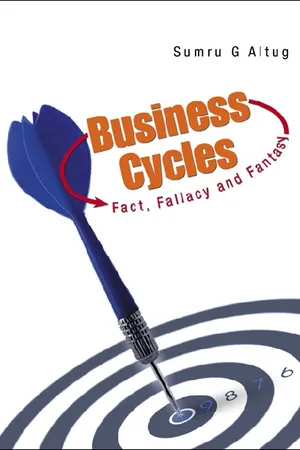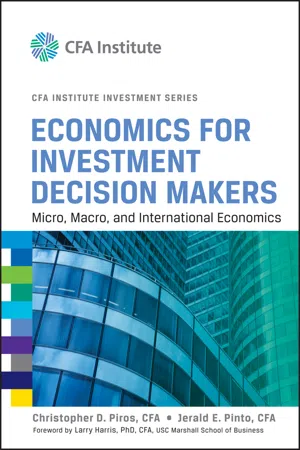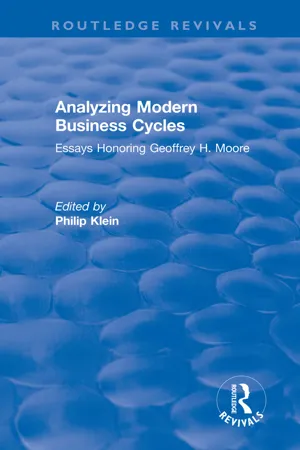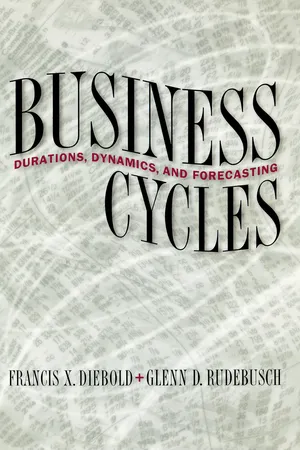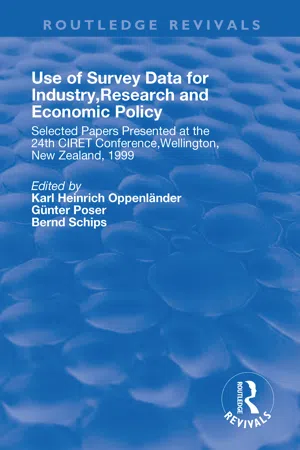Economics
Business Cycle and Economic Indicators
The business cycle refers to the recurring pattern of expansion and contraction in an economy. It typically consists of four phases: expansion, peak, contraction, and trough. Economic indicators are statistics that provide insight into the current and future health of the economy, such as GDP, unemployment rate, and consumer confidence. These indicators help to track and analyze the business cycle.
Written by Perlego with AI-assistance
Related key terms
1 of 5
12 Key excerpts on "Business Cycle and Economic Indicators"
- eBook - ePub
- Les Ruddock(Author)
- 2008(Publication Date)
- Routledge(Publisher)
from the short to the long term with an analysis of building cycles.Business cycles
Fluctuations in levels of economic activity are quite common in developed countries. These movements are known as business cycles. A business cycle usually has four distinct phases: the upswing or recovery phase, the peak, the downswing phase and the trough. In the US, reference is often made to expansions or contractions in economic activity. Business cycles are said to be recurring, but not periodic (i.e. not perfectly regular). A distinction is often made between classical business cycles and growth cycles (Mintz, 1974; Zarnowitz, 1985, 1992; Boehm, 1990; Cloete, 1990; Klein, 1990; Mankiw, 1990). When gross domestic product declines in absolute terms from peak to trough, it is known as a classical cycle. Growth cycles are identified by variations in the rate of growth of gross domestic product. As economies developed rather rapidly in the post-war period, growth cycles predominated. The duration of business cycles normally varies from 3 to 7 years, measured from peak to peak or from trough to trough. Sometimes, however, they can last for a decade, as was the case in the US during the 1990s (Zarnowitz, 1999).Quantitative leading economic indicators
Origins of quantitative leading indicators
Quantitative leading economic indicators form part of a system of leading, coinciding and lagging indicators developed by the National Bureau of Economic Research (NBER) in the US. This system is often referred to as the ‘NBER methodology’. It consists of a scoring system for the assessment and selection of economic indicators. Sometimes, it is referred to as the ‘business cycle indicators approach’. Development of this methodology can be traced back to the early works of writers such as Arthur F Burns and Wesley C Mitchell (1946). In his recent book, Alan Greenspan (2007: pp. 184–185) mentions that Burns was one of his predecessors at the US Federal Reserve and described him as ‘an economist who did groundbreaking work on business cycles’. The initial work was followed up by Geoffrey Moore, Julius Shiskin, Victor Zarnowitz, Charlotte Boschan, Philip Klein, Kajal Lahiri, Anirvan Banerji and others who continued the research, further developing and refining the selection, scoring and compilation of leading economic indicators. This method of business cycle research, or variations on the theme, is currently being used in most developed countries for the analysis of economic conditions and prospects. - eBook - ePub
- Norman Frumkin(Author)
- 2015(Publication Date)
- Routledge(Publisher)
1 Attributes of Economic Indicators The statistics central to evaluating and forecasting the macro economy of the United States are often referred to as economic indicators. This chapter discusses several conceptual and statistical topics that underlie the indicators: business cycles, determining cyclical turning points, seasonality, index numbers, data accuracy, calculating and presenting growth rates, price-adjusted dollars, the underground economy, distinctions among “goods,” “services,” and “structures,” the production of economic statistics, and data integrity. BUSINESS CYCLES Business cycles are the recurring rises and falls in the overall economy as reflected in production, income, employment, sales, profits, and prices. They are associated with capitalistic societies in which production, employment, prices, wages, and interest rates are largely determined in the marketplace. They are primarily associated with industrially advanced nations that have highly developed business and financial structures, in contrast to developing nations that have a large agricultural component that is subject to the vagaries of weather and the consequent abundant or poor harvests. Business cycles reflect the inability of the marketplace to accommodate smoothly such factors as shifting markets for new and substitute products, new technologies, uncertainties and risks in business investments, stock market speculation, global competition and currency volatility, terrorism, and shortages and gluts created by wars (including their buildups and aftermaths), weather-dependent harvests, and the manipulation of supplies and prices by cartels. Economists have offered various theories to explain the causes of business cycles in the past, and they continue to provide varying explanations today. 1 The theories are tested empirically against the movements of the relevant economic indicators to determine how well the theories conform to the data - eBook - ePub
- (Author)
- 2023(Publication Date)
- Wiley(Publisher)
A diffusion index reflects the proportion of a composite index of leading, lagging and coincident indicators that are moving in a pattern consistent with the overall index. Analysts often rely on these diffusion indexes to provide a measure of the breadth of the change in a composite index.2. Overview of the Business Cycle
Learning Outcome
The candidate should be able to:- ☐ describe the business cycle and its phases
Business cycles are recurrent expansions and contractions in economic activity affecting broad segments of the economy. In their 1946 book “Measuring Business Cycles”, Burns and Mitchell define the business cycle as follows:Business cycles are a type of fluctuation found in the aggregate economic activity of nations that organize their work mainly in business enterprises: a cycle consists of expansions occurring at about the same time in many economic activities, followed by similarly general recessions, contractions, and revivals which merge into the expansion phase of the next cycle; this sequence of events is recurrent but not periodic; in duration, business cycles vary from more than one year to 10 or 12 years.This definition is rich with important insight. First, business cycles are typical of economies that rely mainly on business enterprises—therefore, not agrarian societies or centrally planned economies. Second, a cycle has an expected sequence of phases, alternating between expansion and contraction, or upswings and downturns. Third, such phases occur at about the same time throughout the economy. Finally, cycles are recurrent; they happen again and again over time but not in a periodic way; they do not all have the exact same intensity and duration. Exhibit 1 provides an illustration of the pattern of economic growth rate in developed markets. - eBook - PDF
- John E. Marthinsen(Author)
- 2020(Publication Date)
- De Gruyter(Publisher)
Chapter 14 Business Cycles What are business cycles, and why are they important to business managers? What causes them, and who determines when recessions or expansions start and end? After centuries of fluctuating economic activity, have nations gotten better at controlling or predicting business cycles, or are they as frequent, extreme, and fickle as ever? The Basics What Are Business Cycles? Business cycles are recurring , irregular , and unsystematic movements in real economic activity around a long-term trend. They are recurring because down-turns and upturns in real economic activity have occurred for as far back as his-tory is written, and these cycles will surely continue in the future. Unlike the smooth and symmetric patterns of sound or light waves, business cycles are ir-regular and appear as jagged, uneven movements around a long-term trend. Business cycles are also unsystematic, which means they are random and diffi-cult (some believe impossible) to predict. A considerable amount of time and effort has been devoted to predicting business cycles. Unfortunately, most of these predictions have been highly inaccurate. How Are Business Cycles Measured? Figure 14.1 shows a hypothetical business cycle. A recession occurs when there is a significant contraction in economic activity, which is spread broadly across the economy and lasts for more than a few months. The duration of a recession is from the peak of the business cycle to the trough (i.e., low point). An expansion is precisely the opposite. It occurs when broad-based eco-nomic activity improves significantly and is sustained for more than a few months. The duration of an expansion is from the cycle ’ s trough to its peak. The entire business cycle can be measured from one peak to the next peak, or it can be measured from one trough to the next. In Figure 14.1, the business cycle is measured from peak to peak. https://doi.org/10.1515/9781547401437-014 - eBook - PDF
Business Cycles: Fact, Fallacy And Fantasy
Fact, Fallacy and Fantasy
- Sumru G Altug(Author)
- 2009(Publication Date)
- World Scientific(Publisher)
Nevertheless, the notion of a “business cycle” is also concerned with the co-movement of a large number of economic variables. Section 2.2 discusses these properties of business cycles. 2.2. STYLIZED FACTS In this section, we provide some stylized facts of business cycles. These facts constitute important benchmarks by which to judge the performance of alternative models of business cycles. We consider a measure of the business cycle as the co-movement of the cyclical behavior of individual series with 16 Business Cycles: Fact, Fallacy and Fantasy the cyclical component of real output. According to this approach, variables that move in the same direction over the cycle as real output are procyclical . Variables that move in the opposite direction (rise during recessions and fall in expansions) are countercyclical . Variables that display little correlation with output over the cycle are called acyclical . We can also examine whether different time series are out of phase with real GDP. For example, a leading indicator reaches a peak before real GDP reaches its peak and bottoms out (reaches a trough) before real GDP. Leading indicators are useful for predicting subsequent changes in real GDP. Coincident indicators reach a peak or a trough at roughly the same time as real GDP. Finally, lagging indicators reach a peak or trough after real GDP. The stylized facts of business cycles are typically defined in terms of the behavior of the main components of GDP , hours , productivity , real wages , asset returns and prices , and monetary aggregates . These have been described in a number of economic studies. 1 Information on leading indicators is also collected by the Conference Board. 2 The salient facts of a business cycle can be described as follows: 1. Real output across virtually all sectors of the economy moves together. In other words, the contemporaneous correlation of output in different sectors of the economy is large and positive. - Available until 25 Jan |Learn more
- Rob Dransfield(Author)
- 2013(Publication Date)
- Taylor & Francis(Publisher)
This chapter outlines the nature of some of the key indicators and shows what they measure. For example, changes in gross domestic product (GDP) can be used to measure economic growth and changes in the consumer price index can be used to measure inflation. Studying changes in key economic indicators will give you a much better grasp of fundamental changes taking place in the economy. Business analysts should regularly monitor economic indicators to get a better understanding of changes taking place in the economic environment.10.2 What are economic indicators?Economic indicators are things that can be measured that tell us something about what is happening in the wider economy. Just as in a car you have gauges showing the amount of petrol in the petrol tank, the oil level and the engine temperature, so too we have indicators which show the overall growth of the economy, the level of inflation, the unemployment level and so on. These indicators are very helpful to economists and to analysts planning the strategy of a business.Many of the statistics that are used to construct economic indicators are collected by the Office for National Statistics (e.g. changes in employment and jobs, and changes in prices of goods). Other statistics are collected and recorded by the Bank of England, other banks, and the Treasury.On 12 July 2012 the opening page of the UK Office for National Statistics website revealed the following key statistics:- GDP –0.3 per cent
- Consumer price index (CPI) 2.8 per cent
- Unemployment rate 8.2 per cent
Reflective question 1. What do you think the three economic indicators set out above indicate? Note that the first one shows a minus figure.In the sections that follow we will outline the significance of these three indicators which relate to the growth of the economy (changes in GDP), changes in average prices (changes in the CPI), and the rate of unemployment in the economy.Key TermsThe Office for National Statistics – the UK’s largest independent producer of official statistics and the recognized national statistical institute in the UK. The mission statement of this organization is ‘Trusted statistics – understanding the UK’.Bank of England statistics – (available at www.bankofengland.co.uk/ - eBook - PDF
Economics for Investment Decision Makers
Micro, Macro, and International Economics
- Christopher D. Piros, Jerald E. Pinto(Authors)
- 2013(Publication Date)
- Wiley(Publisher)
10 The Conference Board, Business Cycle Indicators Handbook (2001): 14, 15. 320 Economics for Investment Decision Makers EXHIBIT 6-7 Leading, Coincident, and Lagging Indicators—United States Indicator and Description Reason Leading 1. Average weekly hours, manufacturing Because businesses will cut overtime before laying off workers in a downturn and increase it before rehiring in a cyclical upturn, these measures move up and down before the general economy. 2. Average weekly initial claims for unemployment insurance This measure offers a very sensitive test of initial layoffs and rehiring. 3. Manufacturers’ new orders for con- sumer goods and materials Because businesses cannot wait too long to meet demands for consumer goods or materials without ordering, these gauges tend to lead at upturns and downturns. Indirectly, they capture changes in business sentiment as well, which also often leads the cycle. 4. Vendor performance, slower deliv- eries diffusion index a By measuring the speed at which businesses can complete and deliver an order, this gauge offers a clear signal of unfolding demands on businesses. 5. Manufacturers’ new orders for non- defense capital goods In addition to offering a first signal of movement, up or down, in an important economic sector, movement in this area also indirectly captures business expectations. 6. Building permits for new private housing units Because most localities require permits before new building can begin, this gauge foretells new construction activity. 7. S&P 500 stock index Because stock prices anticipate economic turning points, both up and down, their movements offer a useful early signal on economic cycles. 8. Money supply, real M2 Because money supply growth measures the tightness or looseness of monetary policy, increases in money beyond inflation indicate easy monetary conditions and a positive economic response, whereas declines in real M2 indicate monetary restraint and a negative economic response. - eBook - ePub
Analyzing Modern Business Cycles
Essays Honoring
- Philip Klein(Author)
- 2017(Publication Date)
- Taylor & Francis(Publisher)
Chart 4.3 depicts the behavior of the FRB's industrial production index for manufacturing as a whole. Official business cycle peaks and troughs are indicated as well. The data are plotted logarithmically to reflect rates of change. It is clear that manufacturing production is better behaved during expansions than contractions. Production usually slows as expansions mature. But in recessions, the steepest rates of decline sometimes occur early in the downturn and sometimes late. Adjustment paths during recessions are diverse, suggesting—not unlike the theory of chaos just beginning to be applied to economics—that adjustment processes are complex once the economy turns down. This likelihood is, in fact, suggested by the leading indictor index which exhibits very short leads, if any, at troughs.Chart 4.3 . Industrial Production—Manufacturing.A Summary Indicator Based on Business Cycle Dynamics
As a result of the business cycle dynamics described here, there should be considerable informational content in production, inventory, and orders variables relating to the manufacturing sector. Variables for this sector are, in fact, well represented in the list of leading indicators. Six of the eleven leading indicators are so related; they are:- New orders received by manufacturing, consumer goods and materials, 1982$;
- Contracts and orders, plant and equipment, 1982$;
- Average work week of production workers, manufacturing;
- Vendor performance; percentage of companies receiving slower delivery;
- Change in sensitive materials prices, percentage;
- Change in manufacturing inventories on hand and on order, 1982$.
The six leading indicators reflect various aspects of demand for manufactured goods. All manufacturing orders are reflected in the indicators—those for consumer goods, for materials, and for capital equipment. All unfilled orders are inventories measured in the "on hand or on order" indicator. Unfilled orders are also reflected in the vendor performance indicator. Average weekly hours of manufacturing workers is a proxy for manufacturing production. Changes in production are associated with a change in the work week and/or a change in employment. Typically, hours are adjusted before workers are hired or laid off. Sensitive prices reflect largely those of unprocessed or very partially processed commodities, which are affected by demand before prices at a later stage.3 - eBook - PDF
Business Cycles
Durations, Dynamics, and Forecasting
- Francis X. Diebold, Glenn D. Rudebusch(Authors)
- 2020(Publication Date)
- Princeton University Press(Publisher)
Question 3: What Are the Defining Characteristics of the Business Cycle? In the discussion of question 2 (on whether expansions and contractions die of old age), we argued that there is little evidence for periodicity or regularity in the timing of the business cycle. Instead, there are two widely acknowledged key characteristics of the cycle. First, a large 13 This refers to the weak periodicity of chapter 4. It differs from the strong periodicity that would be evident in spectral analyses as in, for example, Howrey (1971). 14 CHAPTER 1 number of macroeconomic variables appear to move together; we speak of the co-movement of economic series over the cycle. Second, fluctua-tions in economic activity exhibit persistence; deviations from the aver-age or trend level of activity are maintained for considerable lengths of time, as alternations between expansion and recession are fairly slow and broadly diffused throughout the economy. The prewar literature focused on the first characteristic, co-move-ment among macroeconomic variables, as the denning attribute of the business cycle; the work of Burns and Mitchell (1946) remains a classic distillation. Chapter 6 provides a modern interpretation of the Burns and Mitchell focus, drawing heavily on the idea that some shocks are sector-specific, whereas others are common, and that the common shocks naturally produce co-movement. Formal models in that vein are said to display factor structure. Dynamic factor models have strong intuitive appeal for business cycle analysis: We observe hundreds of business cycle indicators, each of which fluctuates in part because of dependence on a latent common macroeconomic factor, which repre-sents aggregate macroeconomic shocks, and in part for idiosyncratic reasons. Static factor models have a long history in multivariate statistical analysis, but dynamic factor models are a more recent construct. - Bernard S. Katz, Ronald E. Robbins, Bernard S. Katz, Ronald E. Robbins(Authors)
- 2017(Publication Date)
- Routledge(Publisher)
In the construction of his index numbers Professor Mitchell has taken the period 1890–1900 as a basis. A shifting base would perhaps have yielded slightly more exact results, but it is doubtful whether the gain would have been sufficient to warrant the additional labor involved. A more serious matter is the use of the calendar year in the measurement of changes in business conditions. When the investigator is concerned with broad general tendencies over a long period of time, annual figures serve the purpose. But, in the case of the business cycle, it is a series of changes which follow one another in rather quick succession that are to be measured. Here figures showing changes by months would seem to be required. The statistical data as presented, for example, do not show in comparable fashion the effects of the crisis in 1893, which began in the spring, and that of 1907, which began in the early autumn. They are still less serviceable for the determination of the relative severity of the business reactions which followed these crises.For those particular aspects of the business cycle, however, which are subjected to detailed analysis by Professor Mitchell, the method of presenting the statistical data which he has adopted seems to be entirely adequate. He does not much concern himself with the quantitative analysis of business cycles. Differences in degree and duration are held to be of minor significance. He is rather seeking to discover and determine the causes of uniformities among business cycles. That all business cycles have features in common, the statistical data as presented afford ample proof, and it is not probable that on these aspects of the business cycle monthly figures would have yielded important additional information.Nearly a third of Professor Mitchell’s treatise is devoted to an analytical explanation of the uniformities among business cycles. During each business cycle there are decided but uneven fluctuations in the prices of particular commodities and kinds of labor, marked variations in the physical volume of trade, in rates for loans, in the yield of securities, and in the efficiency of labor. As a consequence of all of these variations there are wide fluctuations in money costs of production and in business profits. All these variations, it is argued, are an inevitable consequence of the existing organization of economic activities upon a pecuniary basis, in which the principal directing influence is exercised by business men in the quest of profits. During a period of prosperity, for example, industry becomes subject to numerous stresses and strains of increasing intensity owing to the business undertakings which are occasioned by, and which in turn occasion, the various fluctuations mentioned above. Finally, a reaction becomes inevitable, and during the subsequent period of depression changes in the opposite direction pave the way for another period of activity for the beginning of a new cycle.- eBook - PDF
- Michael K. Evans(Author)
- 2008(Publication Date)
- Wiley-Blackwell(Publisher)
There is no particular method of determining in advance how long any given upturn will continue. After reviewing the historical record, the general nature of business cycles is briefly reviewed. The length and severity of the downturn depend not only on the initial disturbance, known as impulse, but on the degree to which those effects ripple through the economy, known as propagation. The salient characteristics of each of the four business cycle phases – expansion, upper turning point, con- traction, and lower turning point – are then presented. Attempts to anticipate the upper and lower turning points often rely on the index of leading indicators; yet they never miss a turning point, but they often give false signals. The reasons for this anomaly are briefly discussed. We then turn to a more detailed explanation of the various causes of business cycles. From 1957 through 1990, each recession in the US was preceded by a sub- stantial increase in the rate of inflation and interest rates and tighter monetary policy. However, inflation did not rise at all in the late 1990s, and long-term inter- est rates hardly budged, raising the question of whether the 2001 recession was 562 CYCLICAL FLUCTUATIONS due to entirely different causes than previous downturns. In fact that turns out not to be the case. The 2001 recession can be explained by business cycle theories that were developed long before the advent of Keynesian theory. Economists generally agree that recessions can be caused by four different types of factors: exogenous shocks, changes in technology, incorrect fiscal policy, and incorrect monetary policy. The latter two are not entirely absent in the recent eco- nomic environment, but because of lessons learned in the past, they are far less common, and generally far less important. In the post-WWII period, most of the business cycle fluctuations both in the US and other major industrialized countries can be explained by the first two factors. - eBook - ePub
Use of Survey Data for Industry, Research and Economic Policy
Selected Papers Presented at the 24th CIRET Conference, Wellington, New Zealand 1999
- Karl Oppenlander, Gunter Poser, Bernd Schips(Authors)
- 2018(Publication Date)
- Taylor & Francis(Publisher)
Among the quantitative indicators, we find that 5 of the 6 exhibit one extra cycle during the 5 expansions of traditional length analyzed over the 50 years covered. None has more than one. Further, the average frequency with which one may encounter extra cycles from the quantitative indicators is no more than 2 during the three long expansions. For the six qualitative indicators we also find that extra cycles are generally no more frequent during the traditional expansions than was the case for the quantitative indicators (there is one exception). However, during the long expansions, the picture is radically and consistently different. Extra cycles are far more prominent among the qualitative indicators over long expansions. In fact, they average four times as frequent. One might attribute greater volatility to the fact that qualitative indicators are sensitive to the changing psychological perceptions of economic agents. The findings in this study are widespread and cover too long a period to be due to random factors.Table 6.3 Number of Extra Cycles in Three Long Expansions and in Seven Average Expansions, Quantitative and Qualitative IndicatorsFigure 6.1 Quantitative Leading Indicators (Levels of Economic Activity)Figure 6.2 Qualitative Leading Indicators (Levels of Economic Activity)3 Qualitative Indicators and Growth Rate Cycles
Leading indicators were originally designed to anticipate classical recessions or sustained periods of absolute decline in economic activity. In the 1960s, however, recessions were few and far between and the cycle manifested itself as a period of faster growth interrupted by bouts of slower growth. Such cyclical behavior became known as ‘growth cycles’ as opposed to ‘classical cycles’. Subsequently, there was a move among business cycle students in many countries to study the growth cycle. The international economic indicators (EI) project (Klein and Moore, 1985) started at the NBER in the 1970s. The move was precipitated by Use Mintz’s pioneering study of post-war German cycles (Mintz, 1969), in which she demonstrated the usefulness of growth cycle analysis, based on deviations from trend in economic activity. (Today the OECD, among others, monitors growth cycles for member countries.) We underscore that the calculation of the underlying trend is critical, particularly for the recent past, which is critical for forecasting. These trends, however, are difficult to measure accurately on a real-time basis (Boschan and Banerji, 1990) and are subject to revision (Cullity and Banerji, 1996). They are, therefore, especially suspect when used in forecasting which depends critically on deviations from the most suspect part of the trend - the recent past. To solve this problem, Moore began to use growth rate cycles for the measurement of series which manifested few actual cyclical declines, but did show cyclical slowdowns (Layton and Moore, 1988). Moore’s ‘six month smoothed growth rate’ concept eliminated the need for extrapolation of the past trend in growth cycle analysis. We now call cycles calculated by this method growth rate cycles. For monthly data, the calculation is based on the ratio of the current value of the series to its average during the previous 12 months, expressed as an annual rate by raising to the 12/6.5 power. (For quarterly series, the calculation is the ratio of the current quarter to the average of the proceeding four quarters raised to the 4/2.5 power.) These rates are much smoother than those based on monthly or quarterly changes. Growth rate cycles are episodes in which the overall amplitude of the phase percent change is ‘large’. But the comparison is in terms of smoothed growth rates and so is relative to all the phase amplitudinal changes being examined without any necessity to achieve an arbitrary threshold amplitude change such as the underlying trend as one needs to do in growth cycle analysis. In his extensive study of Swedish business cycles, Klein demonstrated that the growth rate cycle is another effective way to monitor slowdowns (Klein 1998). It has the advantage that peaks in growth rate cycles occur before business cycle peaks—that is, economic activity slows down before it turns down and therefore aids in forecasting potential business cycle developments.
Index pages curate the most relevant extracts from our library of academic textbooks. They’ve been created using an in-house natural language model (NLM), each adding context and meaning to key research topics.

